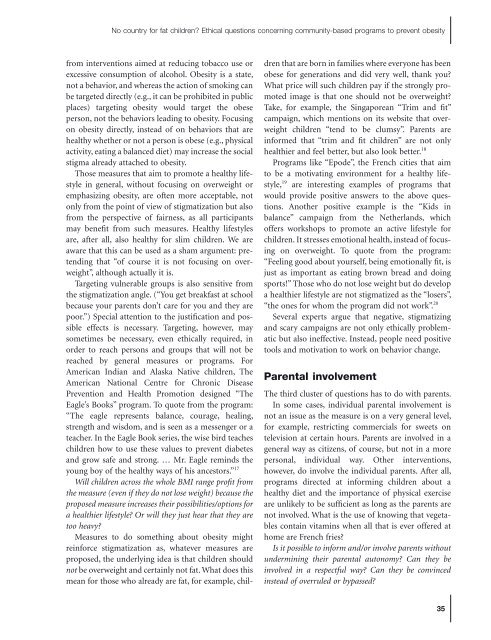Preventing Childhood Obesity - Evidence Policy and Practice.pdf
Preventing Childhood Obesity - Evidence Policy and Practice.pdf
Preventing Childhood Obesity - Evidence Policy and Practice.pdf
Create successful ePaper yourself
Turn your PDF publications into a flip-book with our unique Google optimized e-Paper software.
No country for fat children? Ethical questions concerning community-based programs to prevent obesity<br />
from interventions aimed at reducing tobacco use or<br />
excessive consumption of alcohol. <strong>Obesity</strong> is a state,<br />
not a behavior, <strong>and</strong> whereas the action of smoking can<br />
be targeted directly (e.g., it can be prohibited in public<br />
places) targeting obesity would target the obese<br />
person, not the behaviors leading to obesity. Focusing<br />
on obesity directly, instead of on behaviors that are<br />
healthy whether or not a person is obese (e.g., physical<br />
activity, eating a balanced diet) may increase the social<br />
stigma already attached to obesity.<br />
Those measures that aim to promote a healthy lifestyle<br />
in general, without focusing on overweight or<br />
emphasizing obesity, are often more acceptable, not<br />
only from the point of view of stigmatization but also<br />
from the perspective of fairness, as all participants<br />
may benefit from such measures. Healthy lifestyles<br />
are, after all, also healthy for slim children. We are<br />
aware that this can be used as a sham argument: pretending<br />
that “ of course it is not focusing on overweight<br />
” , although actually it is.<br />
Targeting vulnerable groups is also sensitive from<br />
the stigmatization angle. ( “ You get breakfast at school<br />
because your parents don ’ t care for you <strong>and</strong> they are<br />
poor. ” ) Special attention to the justification <strong>and</strong> possible<br />
effects is necessary. Targeting, however, may<br />
sometimes be necessary, even ethically required, in<br />
order to reach persons <strong>and</strong> groups that will not be<br />
reached by general measures or programs. For<br />
American Indian <strong>and</strong> Alaska Native children, The<br />
American National Centre for Chronic Disease<br />
Prevention <strong>and</strong> Health Promotion designed “ The<br />
Eagle ’ s Books ” program. To quote from the program:<br />
“ The eagle represents balance, courage, healing,<br />
strength <strong>and</strong> wisdom, <strong>and</strong> is seen as a messenger or a<br />
teacher. In the Eagle Book series, the wise bird teaches<br />
children how to use these values to prevent diabetes<br />
<strong>and</strong> grow safe <strong>and</strong> strong. … Mr. Eagle reminds the<br />
young boy of the healthy ways of his ancestors. ” 17<br />
Will children across the whole BMI range profit from<br />
the measure (even if they do not lose weight) because the<br />
proposed measure increases their possibilities/options for<br />
a healthier lifestyle? Or will they just hear that they are<br />
too heavy?<br />
Measures to do something about obesity might<br />
reinforce stigmatization as, whatever measures are<br />
proposed, the underlying idea is that children should<br />
not be overweight <strong>and</strong> certainly not fat. What does this<br />
mean for those who already are fat, for example, children<br />
that are born in families where everyone has been<br />
obese for generations <strong>and</strong> did very well, thank you?<br />
What price will such children pay if the strongly promoted<br />
image is that one should not be overweight?<br />
Take, for example, the Singaporean “ Trim <strong>and</strong> fit ”<br />
campaign, which mentions on its website that overweight<br />
children “ tend to be clumsy ”. Parents are<br />
informed that “ trim <strong>and</strong> fit children ” are not only<br />
healthier <strong>and</strong> feel better, but also look better. 18<br />
Programs like “ Epode ”, the French cities that aim<br />
to be a motivating environment for a healthy lifestyle,<br />
19 are interesting examples of programs that<br />
would provide positive answers to the above questions.<br />
Another positive example is the “ Kids in<br />
balance ” campaign from the Netherl<strong>and</strong>s, which<br />
offers workshops to promote an active lifestyle for<br />
children. It stresses emotional health, instead of focusing<br />
on overweight. To quote from the program:<br />
“ Feeling good about yourself, being emotionally fit, is<br />
just as important as eating brown bread <strong>and</strong> doing<br />
sports! ” Those who do not lose weight but do develop<br />
a healthier lifestyle are not stigmatized as the “ losers ”,<br />
“ the ones for whom the program did not work ”. 20<br />
Several experts argue that negative, stigmatizing<br />
<strong>and</strong> scary campaigns are not only ethically problematic<br />
but also ineffective. Instead, people need positive<br />
tools <strong>and</strong> motivation to work on behavior change.<br />
Parental i nvolvement<br />
The third cluster of questions has to do with parents.<br />
In some cases, individual parental involvement is<br />
not an issue as the measure is on a very general level,<br />
for example, restricting commercials for sweets on<br />
television at certain hours. Parents are involved in a<br />
general way as citizens, of course, but not in a more<br />
personal, individual way. Other interventions,<br />
however, do involve the individual parents. After all,<br />
programs directed at informing children about a<br />
healthy diet <strong>and</strong> the importance of physical exercise<br />
are unlikely to be sufficient as long as the parents are<br />
not involved. What is the use of knowing that vegetables<br />
contain vitamins when all that is ever offered at<br />
home are French fries?<br />
Is it possible to inform <strong>and</strong>/or involve parents without<br />
undermining their parental autonomy? Can they be<br />
involved in a respectful way? Can they be convinced<br />
instead of overruled or bypassed?<br />
35

















